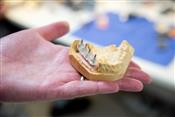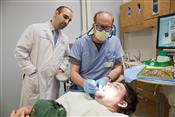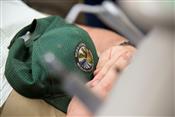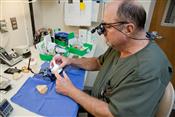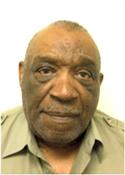New teeth, new jawbone – all in a day
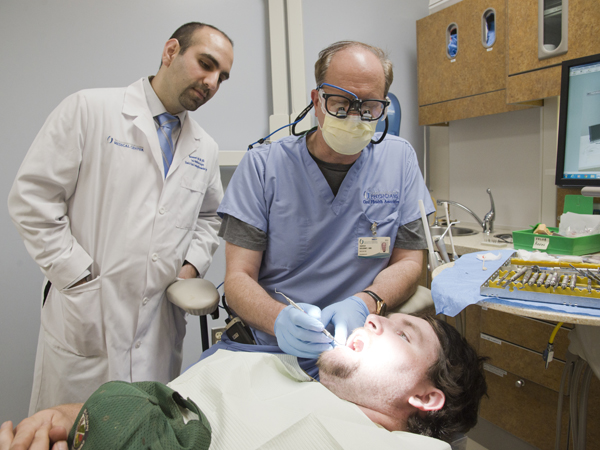
Published in News Stories on August 24, 2015
When the benign tumor in Luther Hunter's right jaw in April 2014 began to take over a sizable portion of his lower right jawbone and its teeth, his specialists at the University of Mississippi Medical Center knew it was time to act.
They had two surgical options. One is a fairly common procedure called a fibula free flap, in which a portion of Hunter's fibula would be transplanted to replace the section of jawbone and soft tissue that must be removed with the fast-growing tumor.

Hunter
But the other option at the time was being done only by surgeons at New York University's Langone Medical Center, the first in February 2011. The surgery is trademarked Jaw in a Day by NYU Langone, and it replaces a complicated reconstructive process to remove the tumor, rebuild the jawbone and give the patient prosthetic teeth that usually is done in stages, over a year's time or longer.
It's made possible by a computer-aided, three-dimensional surgery simulation that allows oral and maxillofacial surgeons to plan the procedure in excruciating detail using cutting-edge digital technology, and to fit with near perfection a dental prosthesis with laboratory-produced teeth that align with the patient's natural teeth.
Patients undergoing fibula free flap wake up with the loss of teeth, but Jaw in a Day calls for that section of fibula to be outfitted with dental posts and prosthetic teeth, even as the bone still receives blood flow in the patient's leg.
Only then is the piece of fibula lifted from the leg and placed in the gap created by removal of the tumor-covered jawbone, where it will fuse with remaining bone and give the patient normal function. The patient wakes up with temporary prosthetic teeth, which are replaced with permanent ones six to 12 months later.

In this illustration, a portion of a patient's fibula replaces a section of jawbone.
Hunter "was very concerned about losing part of his jawbone and some teeth," said Dr. Mohammed Qaisi, assistant professor in the Department of Oral and Maxillofacial Surgery in the School of Dentistry.
"We explained to him that we'd done the fibula free flap before, and the dental implants, and the computer imaging," said Qaisi, an oral, head and neck oncologist and microvascular surgeon. Doing all of those things in the same surgery, though, is cutting-edge and relatively new, he told Hunter.
It takes a major, well-planned team effort that at UMMC includes the expertise of Dr. Harold Kolodney, a maxillofacial prosthodontist, professor of dentistry in the School of Dentistry, and professor of oral oncology in the Department of Otolaryngology and Communicative Sciences in the School of Medicine.
"I had to think about it," said Hunter, 76, a retiree and Starkville resident. "What they were talking about doing was very unusual to me - taking a bone out of my leg and putting it my jaw. But it was a necessary thing. They had to remove the tumor."
Hunter had his surgery May 1, 2014. The team did the same procedure on Pelahatchie resident Jacob Reeves, who suffered from the same fast-growing ameloblastoma tumor, on August 26, 2014. Qaisi and his team performed a third Jaw in a Day surgery on August 18 of this year; that patient is doing well and will be closely monitored for the next three to four months.
In addition to NYU Langone, the JPS Health Network in Fort Worth, Texas, has performed the procedure, its first in October 2014.
"NYU Langone has performed eight procedures, and we expect the program will continue to grow," said Dr. Jamie Levine, a plastic and reconstructive microsurgeon and chief of microsurgery at NYU Langone who was on the first Jaw in a Day surgery team. "We've made significant improvements in the technology since we've started, working closely with 3D Systems, that allow for extremely accurate placement and outcomes."
Colorado-based 3D Systems works with both NYU Langone and UMMC to generate images included in a simulated virtual surgical plan that is very specific to each Jaw in a Day patient.
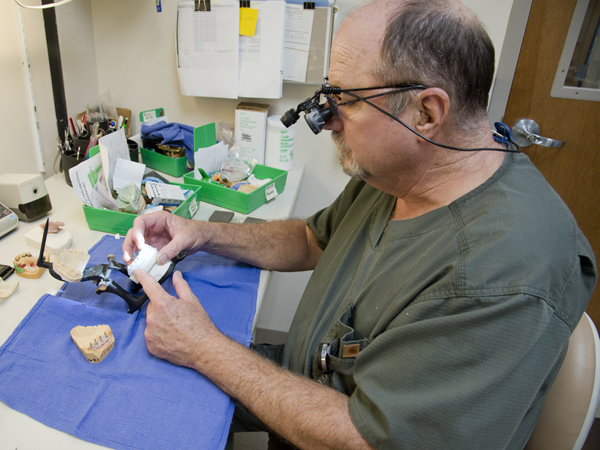
Working with fellow maxillofacial prosthetics specialist Gary Swedenburg, Bill Graham (pictured) checks the color and contour of a bridge that is part of a permanent prosthesis for a patient who underwent Jaw in a Day surgery.
"We have a very unique situation in that we have all the players needed, and all were ready to push forward," Qaisi said. "We have creative thinking on the part of myself and Dr. Kolodney, as well as in-house laboratory technical support from maxillofacial prosthetist Gary Swedenburg.
"Gary helps to design and fabricate the teeth that will be placed on the dental implants. He is also involved in fabricating surgical stents that are crucial in ensuring the correct placement of the teeth in relation to the new jaw bone as well as the adjacent teeth. He is the guy that is making things happen behind the scene."
Reeves' case is unusual in that ameloblastomas are most often diagnosed in patients over 40. He's 24.
"I felt a sharp pain through one of my teeth one day at work," he remembered. Over the next few months, Reeves said, "it was growing into my jaw. It was eating into the calcium on my bones."
He saw his dentist, who sent him to UMMC's School of Dentistry. Doctors there detected a mass on his gums and sent him to Qaisi.
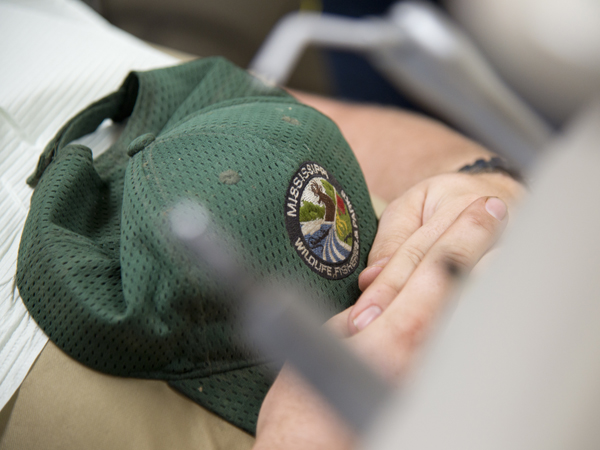
As Dr. Harold Kolodney and Dr. Mohammed Qaisi check prosthetic teeth placed on his implanted dental posts, patient Jacob Reeves relaxes.
Reeves, who works for the state Department of Wildlife, Fisheries and Parks' Turcotte Shooting Facility, returned to Kolodney's office August 14 to have his temporary prosthetic teeth replaced with permanent ones. Hunter did the same on August 7.
"Looking back, I'm glad I did this," Reeves said. "The tumor could have grown bigger."
If a patient doesn't get surgery, they have trouble chewing and will increasingly suffer pain and destruction of bone tissue. The tumor gets so large over time that the patient loses normal jaw function. Their faces becomes swollen and disfigured, and their airway can be affected. Hunter's tumor already was giving him pain, while Reeves was discovered much earlier.
The surgery can last up to 12 hours. It begins with the surgical team completely removing the tumor and affected portion of jawbone. Then they cut into one of the patient's legs to expose the fibula, which isn't needed to support a person's weight and will heal itself after the surgery. Going by their digital plan, surgeons place dental posts in the fibula while the bone is still inside the leg and receiving blood supply, and prosthetic teeth shaded to match the patient's own teeth are placed on the posts.
"A millimeter too high or low can make a difference," Qaisi said. "Everything is planned to the smallest detail. We're so specific with our technology that we can fit each cuspid and molar on the fibula before it's placed in the jaw," he said.
Qaisi and the team use a microscope and hair-thin needles to connect blood vessels so that the new bone and tissue will have good blood supply. "We make sure the bone fits to the adjacent bone, and that the teeth fit to the adjacent and opposing teeth," Qaisi said.
The patient goes to intensive care, where nurses check the new jawbone every hour to make sure that it has good blood flow and that no clots have formed. Patients go home in seven to 10 days, then are closely monitored over the next four months. Qaisi performs a CT scan at the four-month mark to make sure the bone has fully fused.
The preparation for the surgery is every bit as important as what goes on in the operating room, Kolodney said. "You have to see the end result digitally, before the procedure is done," he said. "During the procedure, someone is working on the patient's leg at the same time that someone is working in his oral cavity."
Patients who qualify for the surgery don't come around often. Their tumor condition must warrant the procedure. "If you leave this type tumor, it will eat up your jaw," Qaisi said.
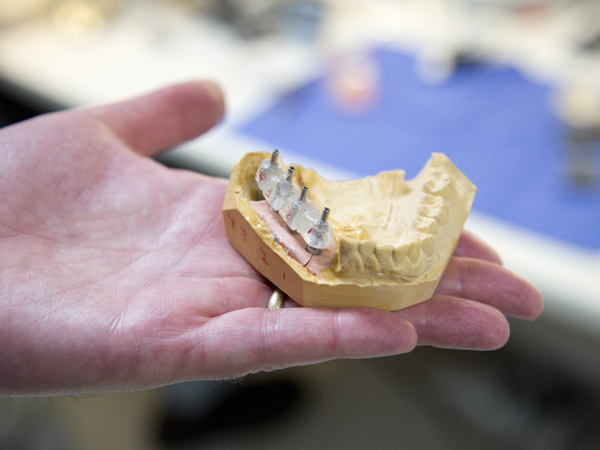
UMMC patients receiving a "Jaw in a Day" procedure come out of surgery with a portion of their jawbone replaced, complete with dental posts and prosthetic teeth on the posts.
"There's no sense in doing the teeth treatment if the rest of the teeth aren't good," Qaisi said. And although insurance generally covers the tumor removal and jaw replacement, it doesn't cover implantation of the dental posts and prosthetic teeth because it's considered cosmetic. The patient must come up with about $10,000 for implants and teeth, or go without them.
"This is not cosmetic," Qaisi said. "They have no choice but to lose part of their jaw."
If a patient's tumor affects his front jaw, Kolodney said, "it would be harder to go for six months to a year without having some of your front teeth," Kolodney said. "This surgery immediately gives them teeth on an interim basis."
The UMMC team's work "speaks very positively to being on the latest cutting edge in rehabilitating patients. It's not just about removing a tumor," Kolodney said. Their technique and findings were in the spotlight earlier this year when they were presented as an abstract at the American Head and Neck Society annual meeting in Boston.
The number of Jaw in a Day surgeries will climb as more people find out it's an alternative to the fibula flap, Qaisi said. "They've both healed very well," he said of Hunter and Reeves.
"I sometimes have pain -- just slight pain every now and then," Hunter said.
"There have been days that I've thought about the 'what ifs,' " Reeves said. "But I'm really happy that I took this path."



